Nuestra Tierra Garden at the Community Food Bank of Southern Arizona
This garden has a 14,700-gallon (66,000-liter) rainwater tank that collects less than a third of the runoff from the adjoining 28,800-square foot (2675-m2) warehouse roof. In a good year of rain, under the current set up, the tank can provide 25 to 33% of the irrigation needs of the adjoining 7,200-square foot (668-m2) food organic garden, composting facility, chicken run, and 300-square foot (27-m2) greenhouse. Though performance could be improved by increasing the amount of rainwater runoff from the roof (including rooftop air conditioning condensate) directed to the tank.
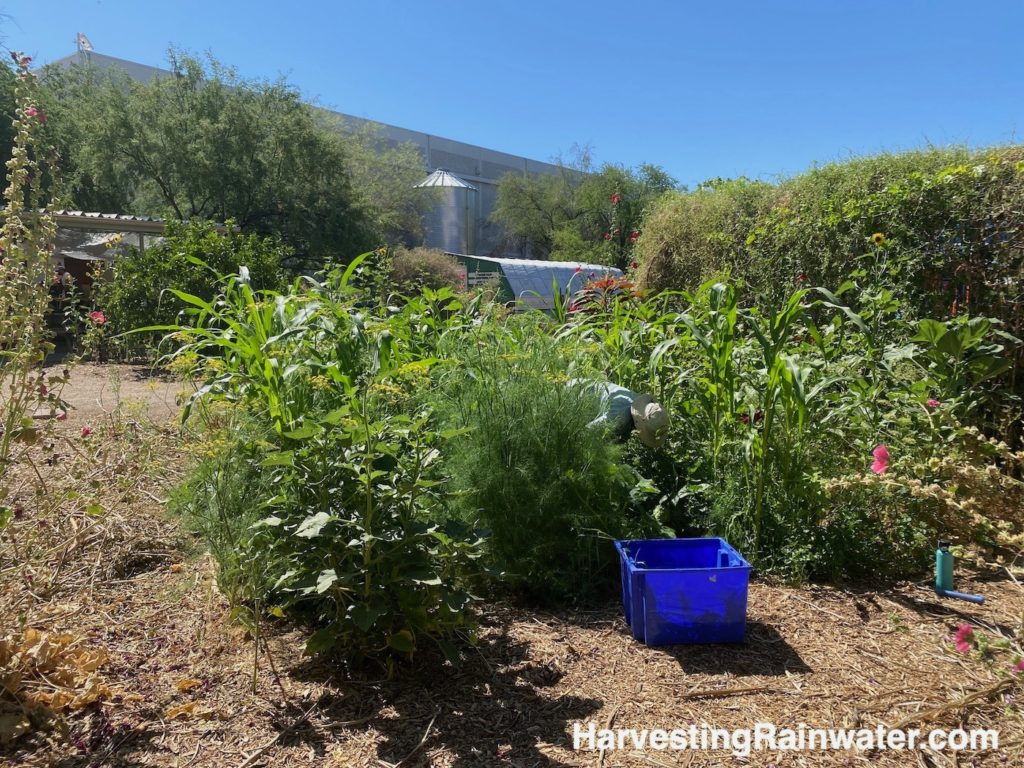
Photo: Brad Lancaster, 5-25-2022
Additional amenities/services include:
• fully-permitted, site-built compost toilet for public use and education
• program teaching how to make, and selling, low-water-use food growing pots made from recycled/salvaged materials that irrigate subsurface with capillary action
• organic food-growing and soil-building workshops and volunteer opportunities
• chicken run and program providing community members with their own backyard chickens
• bilingual garden and rainwater harvesting system managers/coordinators/instructors
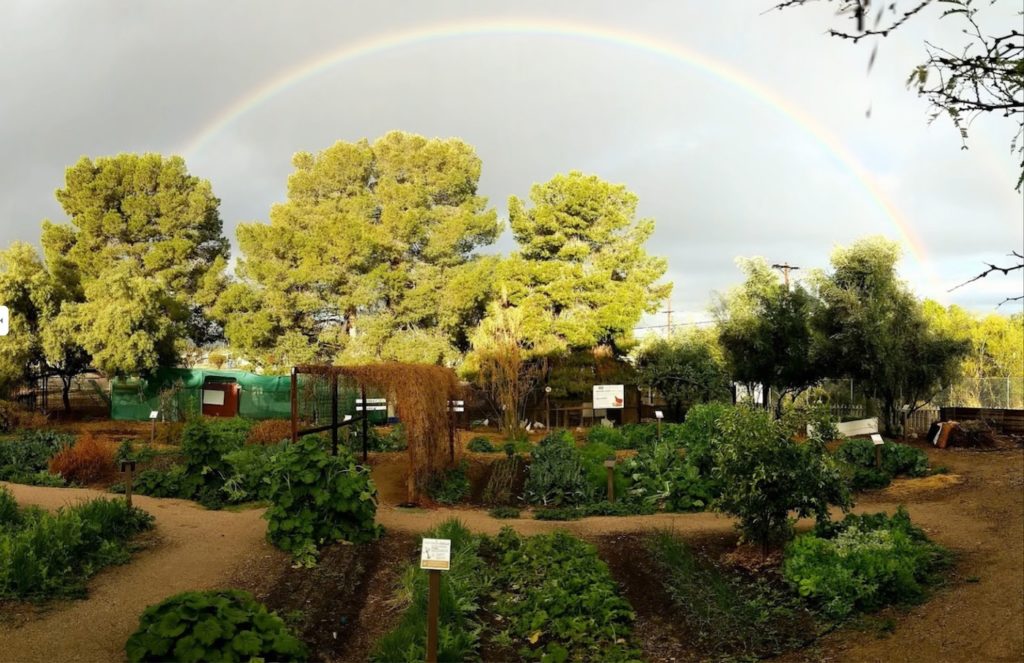
Photo: Brandon Merchant, July 2019
I love that through this garden, and some of its other programs, the Community Food Bank of Southern Arizona is striving to show people how to grow some of their food; and by incorporating water harvesting with water-conserving gardening practices, they are also showing people how they can start to move in a more water sustainable direction.
The 14,700-gallon CorGal cistern was installed by Southern Arizona Raingutters, Inc. in 2009. It is made of corrugated galvanized steel plates bolted together atop a concrete base, and having a waterproof PVC bladder or liner within that holds the water.
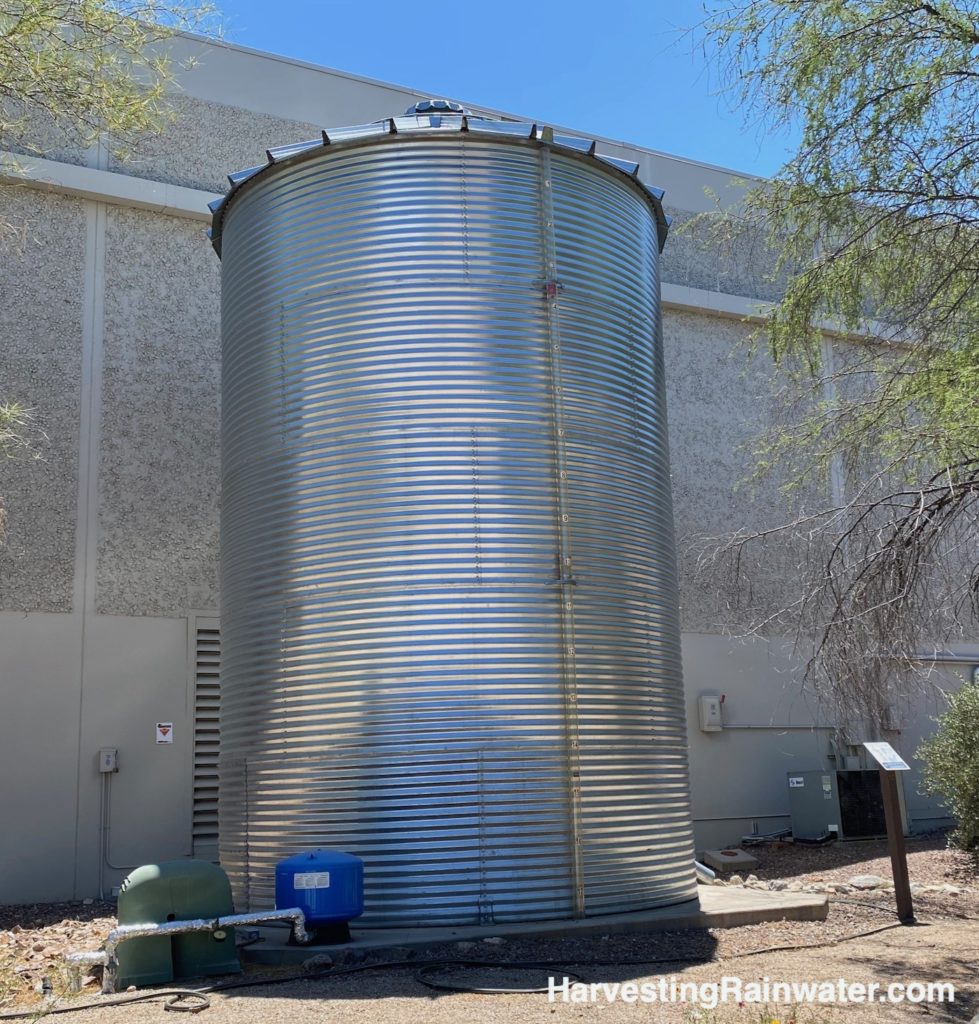
Photo: Brad Lancaster
The tank can overflow into a series of stepped basins planted with trees within the landscape.
How can we make the most of our overflow waters?
How can they regeneratively grow more life, resources, and potential?
In my opinion, the weak southwest sweet acacia (Senegalia farnesiana) trees and invasive African sumac (Rhus lancea) trees currently within and around the cistern overflow basins, could be replaced with a polyculture of hardier and more productive Tucson Basin native food trees such as desert ironwood (Olneya tesota), velvet mesquite (Prosopis velutina), and foothills palo verde (Parkinsonia microphylla). The succession trees could be planted now, and once they grow to good size, the acacia and sumac trees could then be removed and mulched. At the time of this writing, garden manager Brandon Merchant said he’d just gotten permission to replace the weak acacia trees with foothill palo verdes.
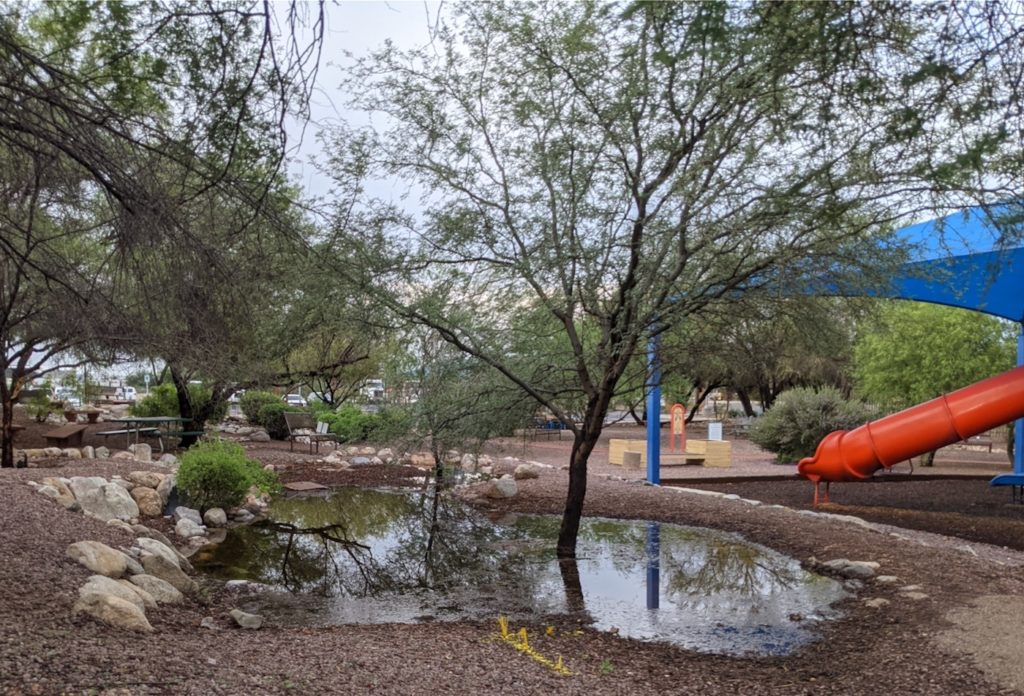
Depth of water is almost 17 inches, but it all infiltrates into the soil thanks to the spongey mulch of organic matter, NOT rock or gravel, in the basin bottom.
Photo: Brandon Merchant
In drier years, the tank does not overflow, nor does it completely fill. This makes it clear to me that there is no current need to increase the tank capacity, but instead more roof runoff needs to be directed to the tank.
Here is more info that makes that case, according to garden co-manager Brandon Merchant,
“The tank would need to fill 13 times in a year for it to be able to provide all the garden’s water needs.
The tank fills 3-5 times in a good year.But prior to 2021’s good summer rains, the tank did not fill for three years (this included 2020-the driest year on record).
However, in the wet summer of 2021 (3rd wettest on record), when the rains were spread out and good – the garden went months on just rainwater.”
Increase the amount of roof area draining to the tank, and you increase the amount of water the tank can capture.
Currently roof runoff is captured from four roof downspouts on the east side of the building. It looks to me that another two downspouts on the north side of the building could be guttered to direct their runoff to the tank as well.
The gutter and downspout would need to be sized to handle the anticipated water volume-see here for how you do that in a residential context.
(I’m basing my recommendation strictly on what I’ve learned from the garden managers and what I’ve observed on site and via Google Maps images. But it would be good to also obtain and review the original design plans and to get on the relatively flat roof to try to better ascertain how much roof area is drained by each roof downspout. Calculations from the calculations appendix in Rainwater Harvesting for Drylands and Beyond, Volume 1, 3rd Edition can then be used to determine the ideal amount of roof area to direct to the tank).
More free on-site waters could be harvested
Additionally, condensate from rooftop air conditioners could be redirected to the rainwater tank.
And at ground level, water from condensate drains from air conditioning units on the west side of the warehouse plus condensate from refrigeration units inside the warehouse (and draining through the west wall) could be redirected to Tucson Basin-native, perennial food plants (all planted within or beside the cistern overflow basins) that could also shade, cool, and screen the air conditioners and the west-facing wall of the warehouse from the hot afternoon sun. See appendix 4 of Rainwater Harvesting for Drylands and Beyond, Volume 1, 3rd Edition for recommended plants. These plantings would also help deflect/mitigate noise from the air conditioners that can be heard in the garden and playground.
(At the time of this writing, the garden had just gotten approval to re-route the condensate from ground-level air conditioners to landscape plantings).
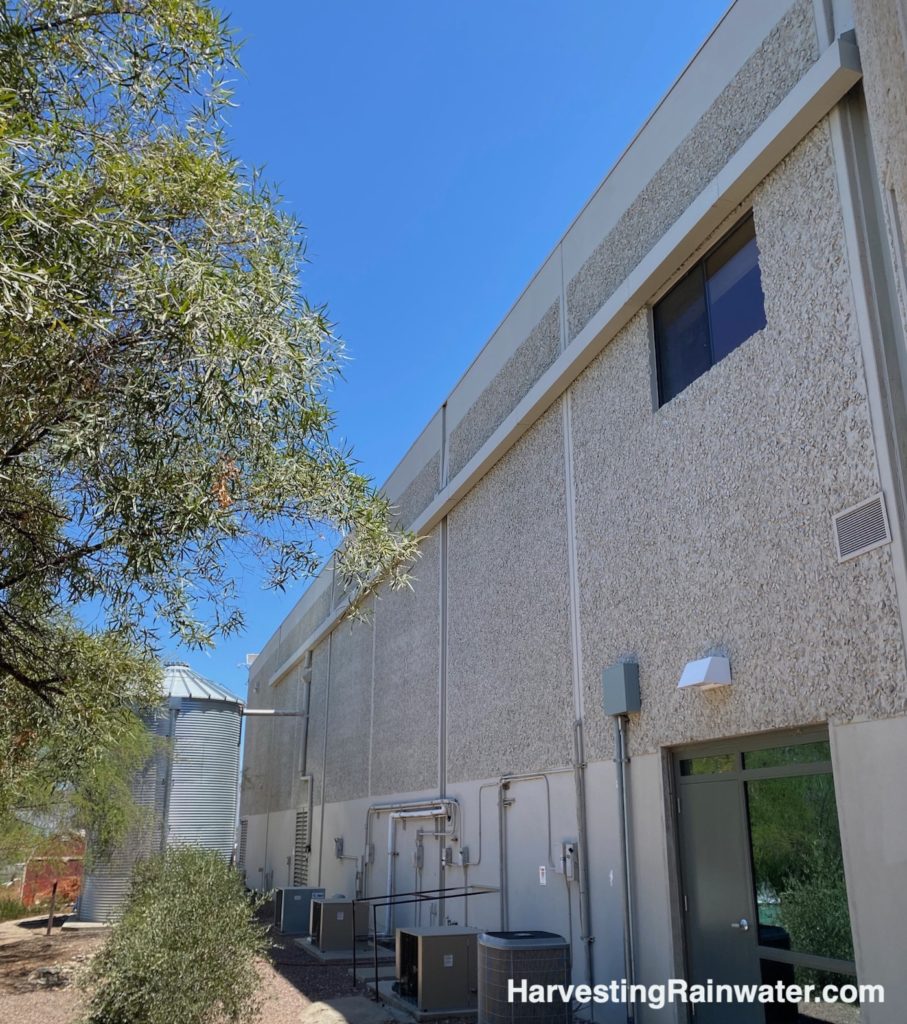
Photo: Brad Lancaster
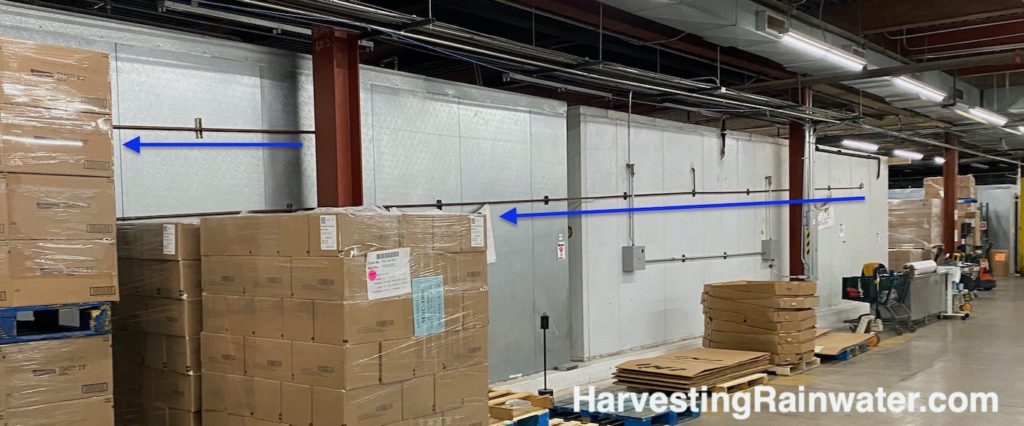
Photo: Brad Lancaster
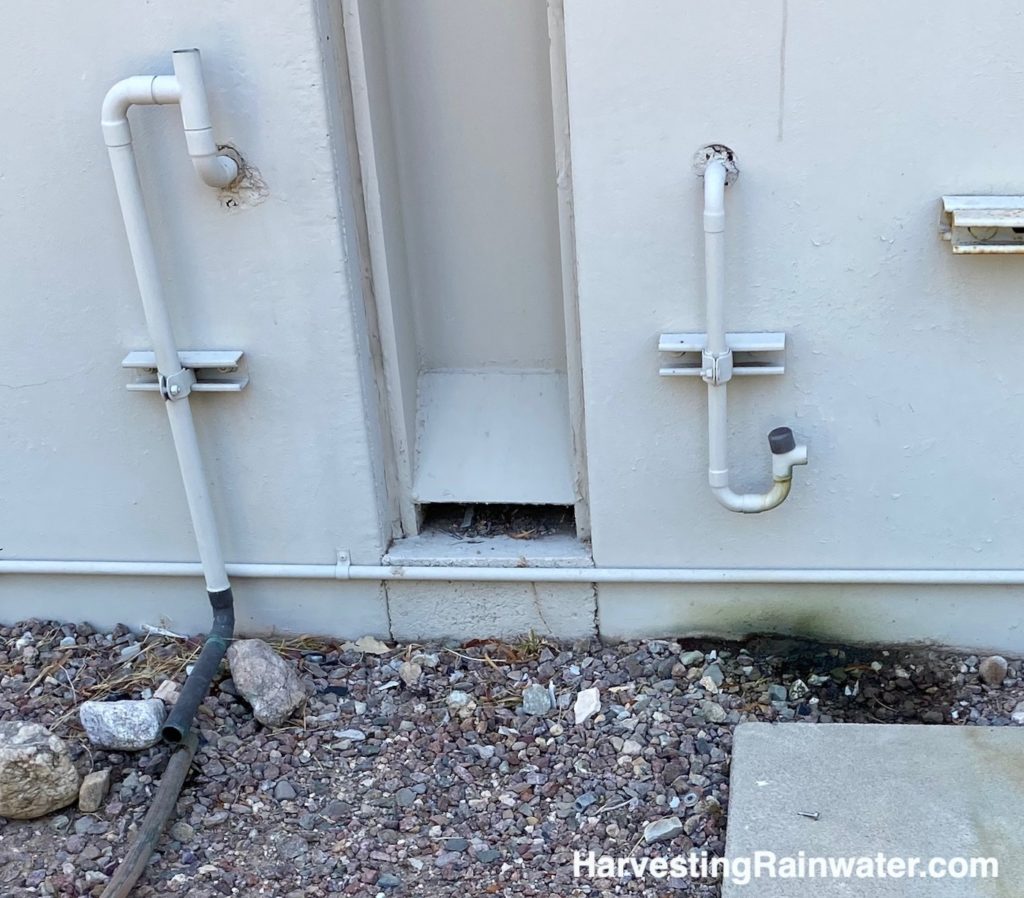
In the hot dry months, the volume of condensate is low, compared to the hot, humid months during the monsoon season when the condensate volume increases.
Photo: Brad Lancaster 5-23-2022
That salt-free condensate, along with the salt-free rainwater could help flush salts introduced from irrigating with salt-rich City water, if the condensate were directed to those irrigated areas.
When rainwater runs out, municipal water is used to water the garden
The cistern is plumbed to a drip irrigation line that waters the garden. When the tank is close to emptying, the garden managers turn a couple valves to shut off the water from the cistern, and then send City water into the irrigation system, and its drip line.
It’s nice that the same irrigation system can take either city water or rainwater.
But what if the power were to go out, or pumps were to break?
Would water still be available?
It does not seem that the rainwater cistern’s irrigation system was designed to use the free power of gravity to distribute the tank’s rainwater to the garden (but setting up gravity-fed systems is very doable), so currently a pump is needed to push the rainwater through the system.
Irrigation system and seasonal watering schedules
The primary irrigation lines use a ½-inch spaghetti tube called “drip line” or “dripper line”. These lines have ½-gallon emitters spaced every 6 inches, so every foot of line emits 1 gallon of water per hour. The lines are spaced based on the water spread in the soil so each garden bed is different, but typically the irrigation lines are about 6-8 inches apart and there are 3-4 lines in each bed. The beds range from 18-30 inches wide and about 8 -18 feet long.
The watering schedule is based on temperature and day length, as temperatures get warmer and days get longer, the watering duration is decreased, but the frequency is increased. As days get shorter and temperatures cool, the duration is increased, but the frequency is decreased. When daytimes highs get to 95˚F and over, garden beds are watered once per day for 30 minutes. As temperatures cool, the irrigation frequency is reduced to every 2 days for 60 minutes, then every 3 days for 90 minutes, and eventually every 4 days for 2 hours. Once they get to a two-hour watering duration, they don’t water any longer than that because that is about the time it takes for the water to reach about 24-inch depth, and the majority of the annual plants they grow don’t have roots that grow much deeper than two feet.
During the monsoon rainy season, the garden coordinators have to monitor their irrigation very closely. If they get heavy rains at the garden, they can turn off the irrigation for a few days, but they have to watch all closely because they can lose plants quickly if they forget to turn the irrigation back on.
The garden is much more forgiving in the winter. According to Brandon, “I would say that in typical winter rainy seasons we can easily go up to 7 days between watering. In good years, if the rain is spaced at the right frequency, 10-14 days between watering would not be out of the question.”
Management of salts from municipal water supply
Irrigating with the municipal water supply water adds a lot of salts to the soil (and our municipal water is getting saltier), which can negatively affect plant health and soil life, if those salts build up too much in the root zone of the soil.
So, the garden managers Brandon and Victor wisely run extra salt-free rainwater through the irrigation system in the rainy season to both flush the salts (from the municipal water) out of the root zone, and expand the capacity of the tank with the garden bed soil.
They do this by continually monitoring the rainwater level in the tank along with the weather forecast. If the tank is near full and a rainstorm rolls in, that is an ideal time to run extra rainwater through the irrigation system. This uses the garden bed soil as a secondary “tank.” By getting the garden beds well-watered with rainwater, the garden beds will be able to go longer before needing another watering from the tank. At the same time, by directing tank rainwater to the garden beds, they make more room in the tank to capture the new rain from the incoming storm. Such management of the tank water ensures more of the valuable salt-free, fertile rainwater goes to the more tender garden plants, rather than to the more drought-hardy plants in the tank’s overflow basins. And those overflow basins will capture direct rainfall and runoff from the surrounding landscape in a storm, even if the tank does not overflow.
Issues with the system/potential improvements
Have the systems been designed for ease of maintenance?
Or could maintenance be made easier, so it is more of a joy than a chore, and thus more likely to be done?
• There was a year the cistern did not work. According to garden manager Brandon Merchant, “We did not know what the issue was, and despite multiple requests to the tank installers, we couldn’t get the tank installers to come out and fix the issue. What had happened, is the PVC bladder on the inside of the tank had come undone—and it needed to be reattached. Thankfully, the tank manufacturer’s vice president just happened to visit the garden, we informed her of the problem, and she got the tank installer to fix the issue the next day.”
• A manual needs to be written up on how to use and maintain the rainwater tank, its pump, and its irrigation system; so, if garden managers Brandon and Victor leave, the next managers will have all the information they need to effectively manage the system.
Are free on-site waters and other resources/potentials, currently being utilized or collaborated with to realize all their potential?
Some things that came to my mind…
• Roof area directing its runoff to the tank could be increased to provide more rainwater for the garden.
• More air conditioning condensate could be directed to the garden for free, salt-free irrigation water.
• If redone in the future, the irrigation system could be redesigned so it could run off gravity-fed pressure (when using rainwater), so it would not be reliant on its pump.
• More Tucson Basin-native perennial food plants could perhaps be utilized – at least around the periphery of the garden, in the cistern overflow basins where they could also help screen the air conditioners and receive their condensate, and around the chicken run to show how these lower-water-use, multi-use native species (which are ideally suited for our local climate, soils, and wildlife) could be incorporated into home gardens and landscapes. Examples can be found in appendix four of “Rainwater Harvesting for Drylands and Beyond, Volume 1, 3rd Edition” and for plants good for chicken runs see here.
What else are we missing, or that we could simplify and make more effective?
We can always evolve if we actively strive to do so.
Other water conserving strategies at garden
• Compost toilet, which transforms human “waste” into a safe and fertile soil amendment as you make your deposits into the carbon cycle, NOT the water cycle; meaning you don’t put human waste into, and then contaminate, drinking water as happens with a flush toilet (drinking water is plumbed to flush toilets).
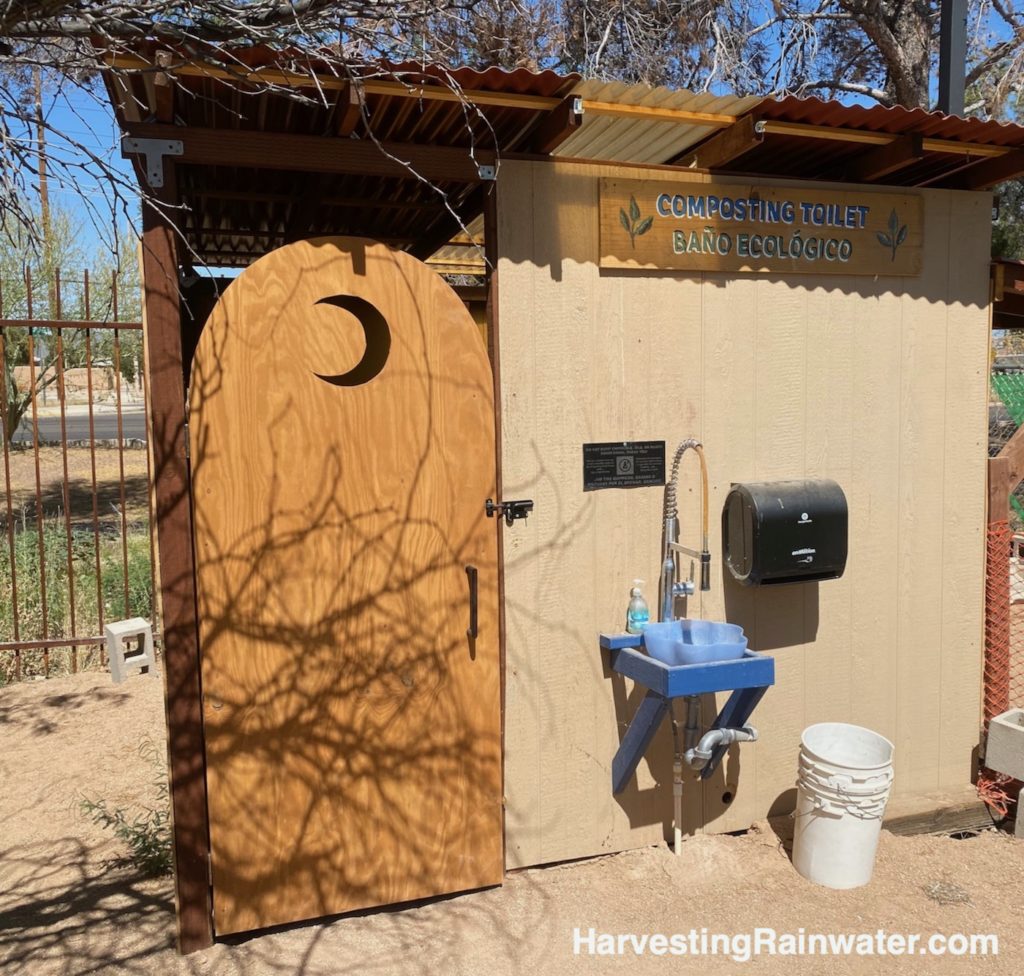
Photo: Brad Lancaster
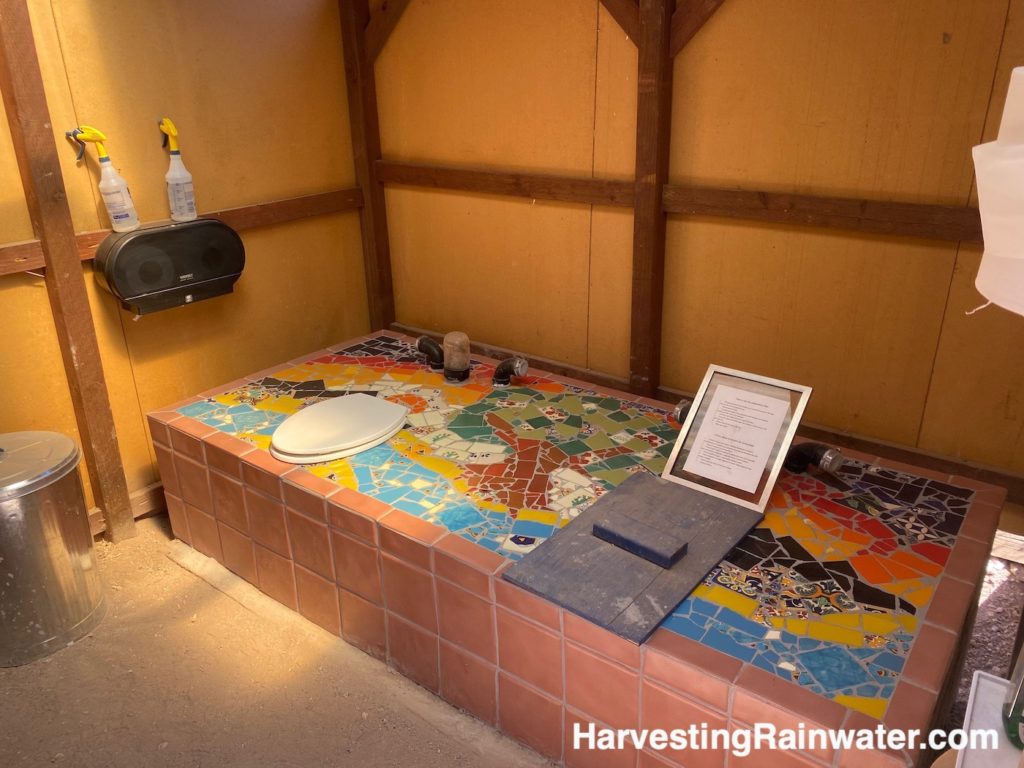
Photo: Brad Lancaster
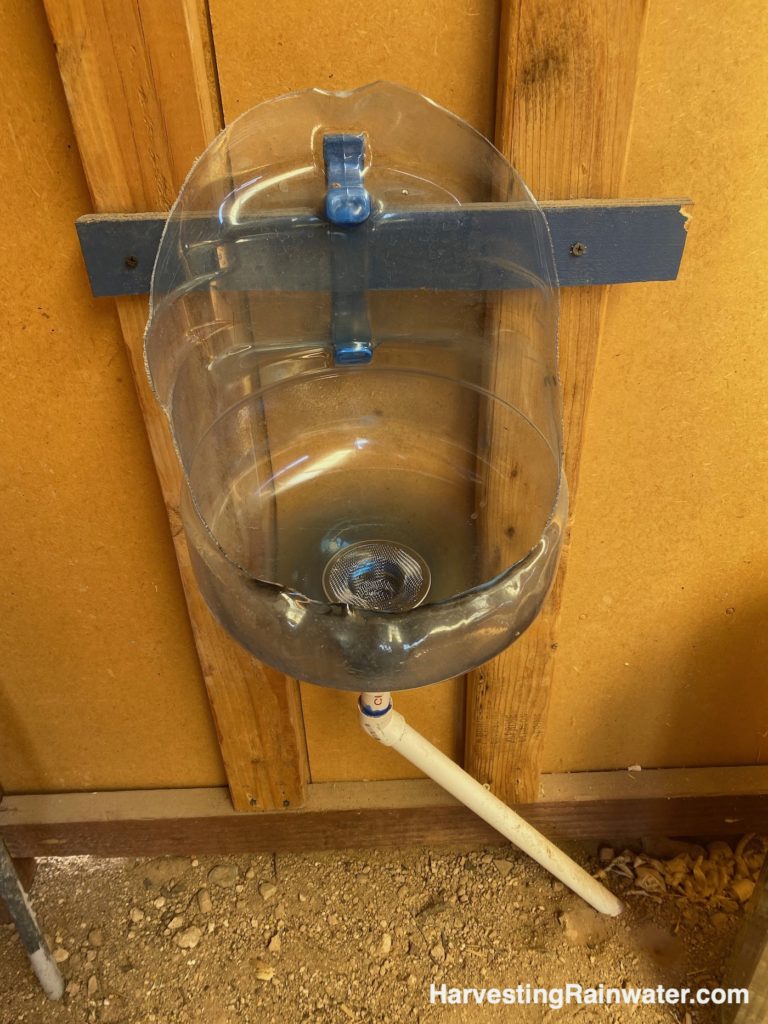
Photo: Brad Lancaster
• Composting
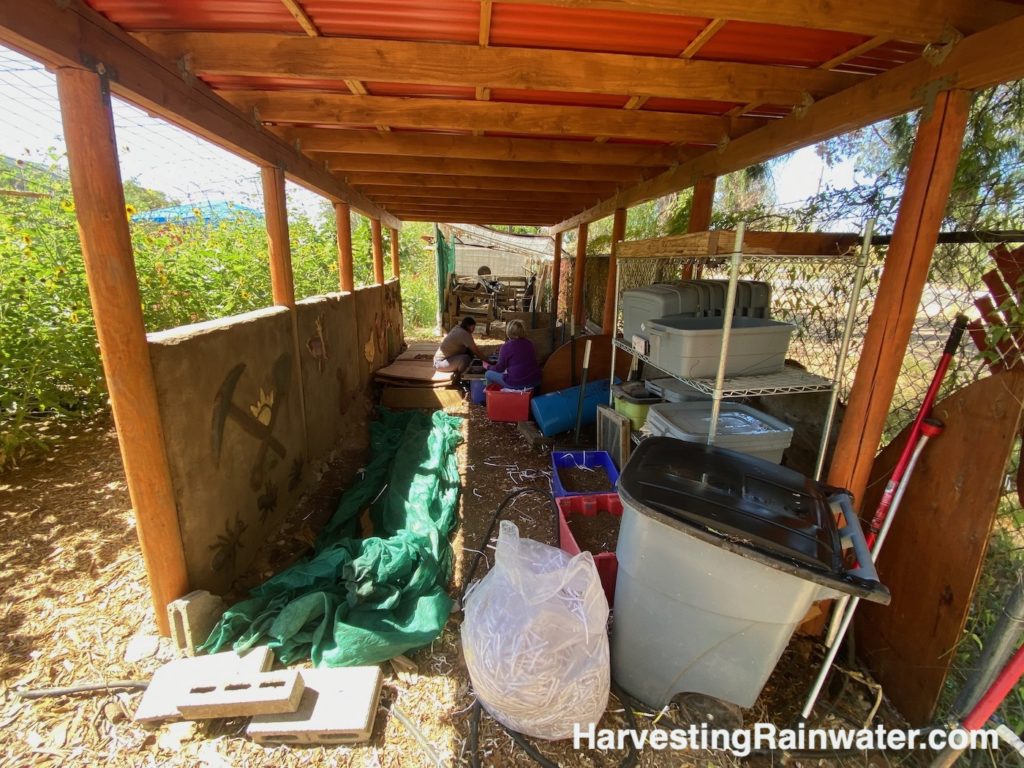
Photo: Brad Lancaster
• Mulching
• Low-water-use, sub-irrigating grow pots.
Workshop show people how to make their own, and they have some available for sale. Many of the materials for the grow pots were previously used, and have been repurposed to reduce plastic consumption and waste.
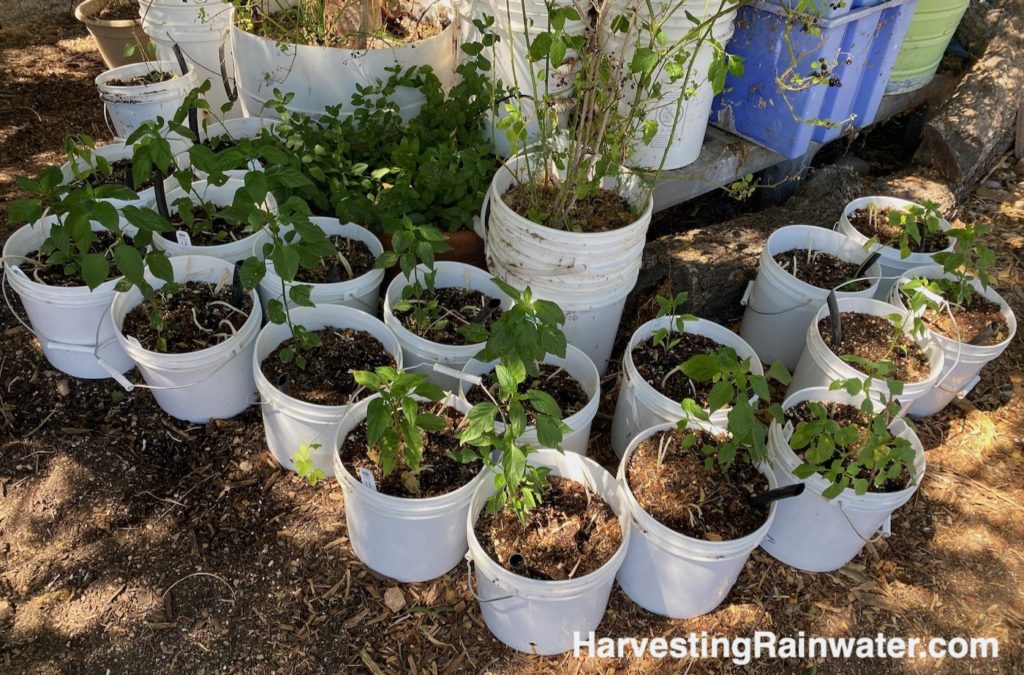
Photo: Brad Lancaster
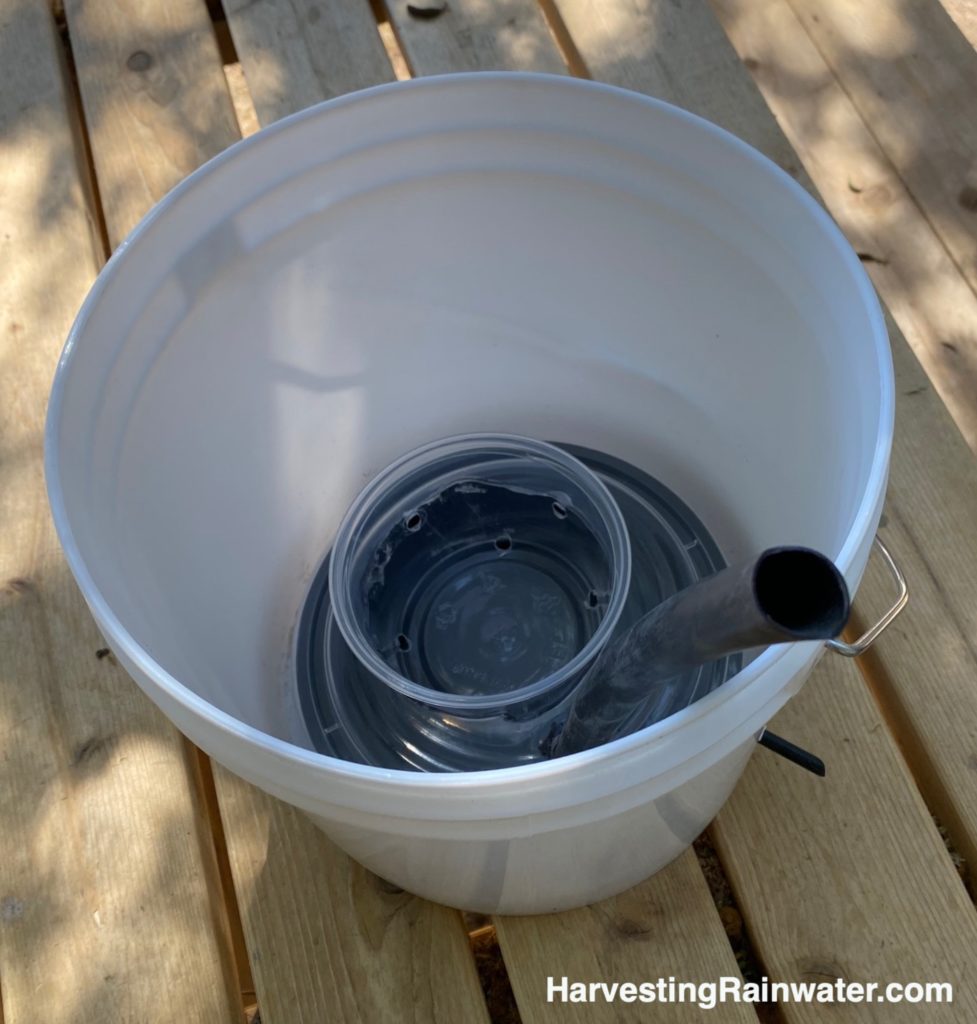
Photo: Brad Lancaster
• Greywater from garden sink drains is directed to freely irrigate plants
• Greenhouse floor drain water is directed to membrillo/quince tree and other edible plantings
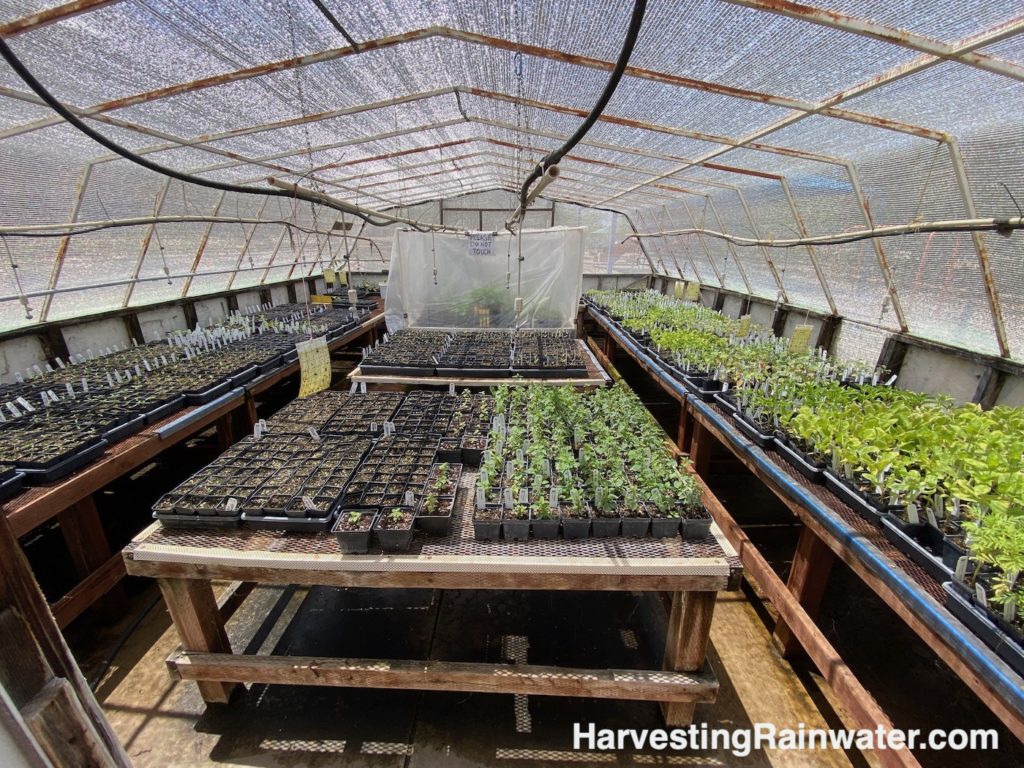
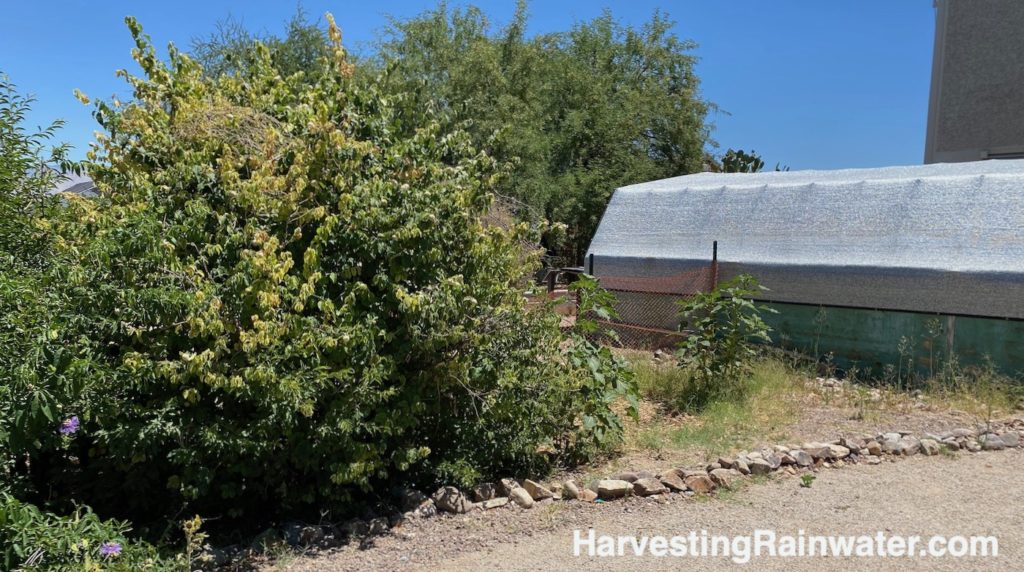
Photo: Brad Lancaster
Many thanks to Brandon and Victor, the Nuestra Tierra Garden managers, for their great work in the garden and their help with answering all my questions for this write up.
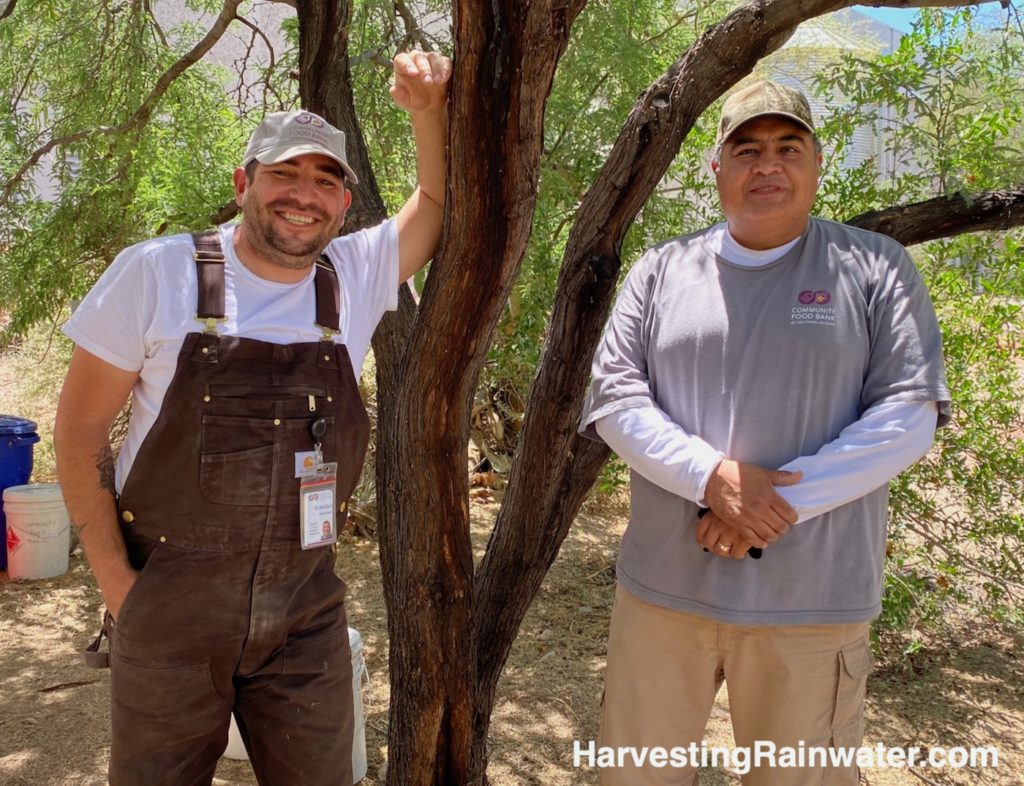
Where:
3003 S Country Club Rd, Tucson, AZ 85713
Go to northwest corner of the property (north of playground)
32.18936196664749, -110.92601573004438
Cost: Free
Hours: Wednesday and Saturday from 7am to 10am
Summer hours – Wednesday and Saturday from 6:30am to 9:30am
More info: Email garden@communityfoodbank.org
This location is included in the following tours:
See the new, full-color, revised editions of Brad’s award-winning books
– available a deep discount, direct from Brad:

Volume 1
This is THE book to assess all your free, on-site water sources, then create an integrated plan to harvest them to grow sustainable abundance!

Volume 2
This book has step-by-step instructions on how to design and implement many different water-harvesting earthworks or rain gardens for many different contexts.
Plant the rain and grow abundance!
